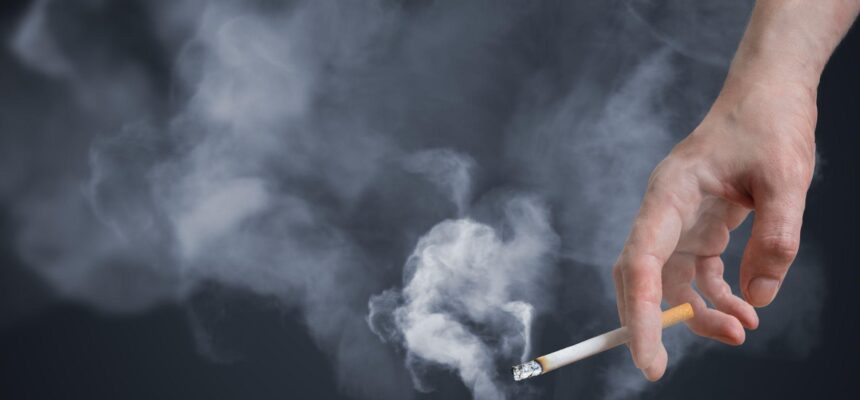
7 Side Effects of Nicotine Addiction
Effects of Nicotine Addiction
- Adrenaline Overworks the Circulatory System
- Brain Chemistry Changes
- Blood Sugar Regulation Is Disrupted
- The Brain Reacts to Changes in Blood Flow and Hormones
- The Gastrointestinal System Is Disturbed
- Nicotine Addiction Develops Rapidly
- Physical Withdrawal Makes Quitting Difficult
Nicotine is one of the most commonly used addictive substances in the United States.
According to the 2023 National Survey on Drug Use and Health (NSDUH) conducted by the Substance Abuse and Mental Health Services Administration (SAMHSA), approximately 22.7% of individuals aged 12 or older in the United States used tobacco products or vaped nicotine in the past month, equating to about 64.4 million people.
Understanding the physical responses to nicotine can help you choose the right tobacco addiction treatment option to break free of this powerful chemical cycle.
What Is Nicotine?

This chemical substance is produced by the tobacco plant (Nicotiana tabacum) or may be created in a laboratory. The nicotine definition is the same no matter the source of the chemical. It is highly addictive in any form and is usually ingested through smoking, chewing tobacco, gum, vaping, or e-cigarettes.
Smoking tobacco is known to increase the risk of lung cancer, and using chew has been linked to mouth cancer. E-cigarettes or vapes may have less of the cancer-causing ingredients than tobacco. However, they still contain the addictive and physically stressful nicotine component.
Health Risks of Nicotine Addiction
Smoking, and specifically a nicotine addiction, can have severely negative health effects including increasing your risk of developing lung cancer and other respiratory diseases. The effects of nicotine on your body’s adrenaline production can also increase your risk of heart attack and other heart-related diseases.
Smoking is still one of the most preventable causes of death in America. According to the Centers for Disease Control (CDC), it accounts for at least 480,000 deaths in the United States every year.
7 Harmful Physical Effects of Nicotine on the Body

Nicotine is extremely fast-acting, reaching the brain in as little as 10 to 20 seconds. The body’s systems begin to react to the drug almost immediately. The primary physiological effects of nicotine are:
1. Adrenaline Overworks the Circulatory System
As soon as nicotine reaches the brain, it stimulates the adrenal glands to produce adrenaline. A chemical energy rush is created with the classic “fight or flight” responses, including these common nicotine effects:
- Elevated heart rate
- Trouble sleeping
- Rapid breathing
- High blood pressure
- Constricted veins
- Possible heart disease
Adrenaline also triggers a sudden release of glucose and can affect the amount of insulin produced by your pancreas. In some cases, this may increase your risk of developing prediabetes or even diabetes.
2. Brain Chemistry Changes
Nicotine causes chemical changes in the brain, including increased levels of endorphins and dopamine. These mood-boosting chemicals stimulate the pleasure centers of the brain. Unfortunately, this temporary effect causes the user to keep returning for more until they develop nicotine dependence.
In some cases, nicotine can help improve focus and concentration. However, these benefits are soon outweighed by nicotine’s tendency to create dependence. Eventually, this dependence can lead to addiction in smokers and users of nicotine or tobacco products like liquid nicotine.
Effects of nicotine like reduced anxiety and elevated mood can quickly lead to severe symptoms of nicotine withdrawal. This happens whenever you stop smoking or using nicotine products.
3. Blood Sugar Regulation Is Disrupted
Nicotine causes the pancreas to produce less insulin, which can lead to higher blood sugar levels. This can feel like a temporary energy boost, followed by an energy crash, interfering with the body’s ability to regulate blood sugar properly.
When combined with nicotine-triggered glucose release, smoking can increase the risk of developing prediabetes, and under certain conditions, may even contribute to the development of type 2 diabetes.
The temporary spike in blood sugar associated with nicotine use can also make quitting smoking more difficult. When someone quits, they may experience withdrawal not only from nicotine but also from the blood sugar fluctuations their body had become used to.
4. The Brain Reacts to Changes in Blood Flow and Hormones
The effects of nicotine on the brain persist for three to five days after using and may cause:
- Vertigo or dizziness
- Disturbed sleep patterns and insomnia
- Nightmares and vivid dreams
- Headaches
These immediate effects are often presumed to be cravings. Because of this, smokers or nicotine users take in more of the drug to try to improve their mood. This significantly contributes to the rapid development of addiction in nicotine users.
5. The Gastrointestinal System Is Disturbed
Nicotine also affects the stomach and digestive system, often causing these troublesome symptoms:
- Indigestion and heartburn
- Nausea and vomiting
- Diarrhea
- Peptic ulcers
- Dry mouth
Similar to the negative effects on your hormones and brain, nicotine can cause you to feel physically ill. Unfortunately, most people turn to more cigarettes to feel better and counteract their negative physical state. This can lead to an even greater risk of getting addicted to nicotine and its effects.
6. Nicotine Addiction Develops Rapidly
It takes very little time to become addicted to such a substance as powerful as nicotine. Why is nicotine so addictive? Simply because all creatures respond to substances that stimulate the pleasure centers of their brains.
When the pleasurable response is short-lived, like in the case of nicotine, humans are immediately spurred to use more of it. This is because they want to continue feeling the “high” they first experienced.
This can lead to developing a habit of using nicotine to feel good. Later, this creates a dependence on the drug and a subsequent addiction. The ritual behavior becomes its own reward.
7. Physical Withdrawal Makes Quitting Difficult
Even after just a few weeks of using nicotine, it becomes difficult to quit. As soon as you stop, nicotine withdrawal symptoms set in. You might experience:
- Headaches and nausea
- Cravings and irritability
- Insomnia
- Anxiety and restlessness
- Increased appetite
- Difficulty concentrating
These powerful addictive properties of nicotine can lead people to keep smoking cigarettes and using other nicotine products. This is usually even against the medical advice of healthcare professionals. Nicotine may stay in your system for up to a week after you stop using nicotine products. Around a week after your last use, your withdrawal symptoms will likely be at their peak.
Unfortunately, smoking cigarettes may have become a habit. As a result, people trying to quit not only have to battle withdrawal symptoms but also resist the urge to maintain a long-term habit accompanied by powerful cravings.
Exploring Nicotine Addiction Treatment Options

If you’ve decided to quit smoking, chewing tobacco, or vaping, there are a number of treatment options to consider. Depending on how long you’ve been using nicotine products, treatment options and withdrawal severity may differ significantly.
You can go at it alone, and some people have been successful at doing so. However, all of these methods work better in combination with behavioral treatment. This type of treatment is only available from a dedicated addiction treatment center.
Treatments offered by these facilities often include:
- Nicotine patch programs to slowly wean off smoking cigarettes while reducing withdrawal symptoms
- Other replacement regimens like nicotine gum, sprays, or inhalers
- Going “cold turkey” with counseling support
- Prescription medications that block nicotine receptors
The very best nicotine addiction treatment programs are some combination of these methods. They approach every patient in a personalized manner that focuses on their personal journey towards seeking treatment for their addiction.
Tobacco or nicotine addiction treatment is like recovery from any other addictive substance. There are experts available to help you regain control and choose a new direction. This is regardless of how powerful your addiction has become.
Nicotine Addiction Treatment From Yellowstone Recovery

Yellowstone Recovery is a highly specialized addiction recovery facility located in California. We offer patients access to customized treatment plans that best suit their personal preferences and treatment needs.
By contacting our expert team for help, we can help assess your addiction and place you in the very best treatment program possible. We will also help you navigate the vital choices to maintain your physical and mental health after addiction recovery.
For more information or to get help for your nicotine addiction today, contact our expert team at (888) 418-4188. You can also explore our website for more details regarding the programs available.








